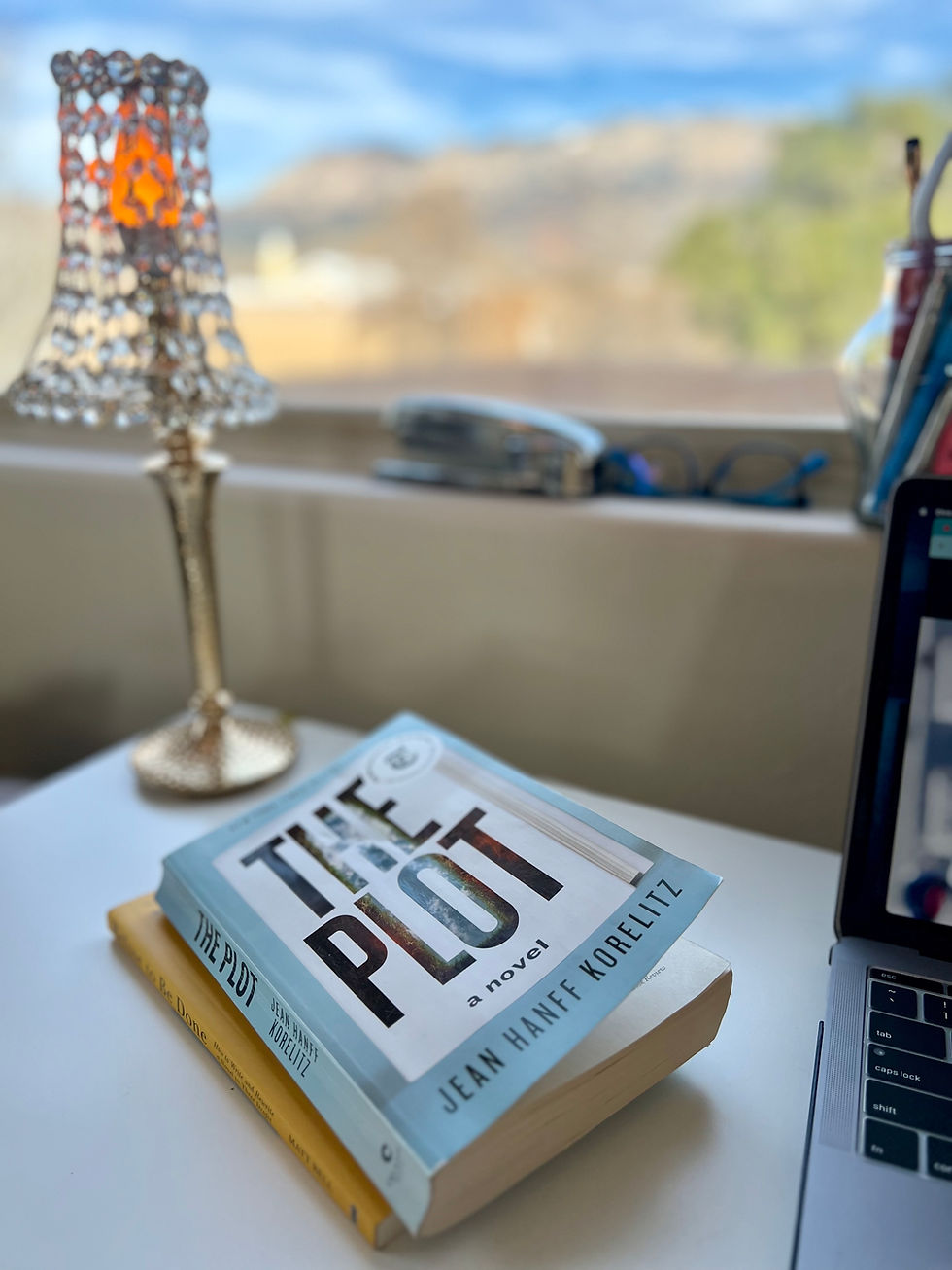The Plot by Jean Hanff Korelitz
- Meg Vlaun

- Feb 13, 2024
- 4 min read

13 February 2024
The Plot by Jean Hanff Korelitz
The premise of this book is that an author, Jacob Finch Bonner, lifts the plot of a novel from one of his former MFA students after he learns that student had passed away. He writes the novel, then publishes it, and it becomes a national bestseller, skyrocketing Bonner to stardom. Out there, however, someone knows that Bonner has lifted the plot from one of his former students; this person then harasses Bonner about “plagiarism” and “theft” of a plot.
Through this antagonist/conflict, Korelitz addresses the ethics surrounding the “borrowing” of stories from others (who did not produce their ideas) and from real life—and brings to mind, for me, the New York Times article, “Who Is the Bad Art Friend?” This article focuses upon a woman who performs this generous act and her supposed “friend,” who writes about that act in a short story that is picked up for publication nationwide. Does that story belong to the woman who performed the act, or the woman who wrote the story? The “generous” woman sues the author for plagiarism and defamation…it gets ugly…there’s no real hard and fast law about who owns a story (before it’s written).
It seems to me that the audience or discourse community for Korelitz’s The Plot is actually popular mystery readers—even if she feigns aiming it at the writerly community. I suspect this because, in the end, the authorship of “the plot” didn’t matter. Spoiler Alert The antagonist didn’t want the story written at all because it would have exposed her for first-degree murder on at least three counts. So the moral conundrum of plot ownership…was irrelevant.
If Korelitz’s audience is presumed to be the writing community, she does poorly to retain their regard by claiming that low-residency MFA programs are a sham and that writers, in general, are “a strange kind of beast…with…petty feuds and…fifty shades of narcissism” (315). Bonner’s snide, down-the-nose tone about low-residency MFA programs and breakout authors was difficult for me to stomach, as I currently attempt both in my own life. I nearly stopped reading for that, alone.
But it was the transparent plot and shallow characters that solidified my bewilderment that it was a New York Times Bestseller. A fifth of the way into this book, we know little about Bonner except that he’s an insecure, weak, failed (or fizzled out) writer. We know this because it’s what he believes of himself. Then, in walks this breezy, beautiful woman with a spotty, vague background who apparently loves Bonner before first sight—and we’re supposed to fall for it when she love-bombs him, moves to the east coast with him, and then marries him within three months. All this to a man in his mid-forties with no self-esteem and no former romantic prospects. Yeah, not likely. As soon as she appeared on the scene, I knew she was our antagonist. So, for me, 1/5 of the way in, there went the plot of Korelitz’s The Plot.
It seems possible that Korelitz intended for us to suspect Anna as antagonist from the start, that the mystery of the story was less who but how. Maybe. But then…the entire plot was already laid in our hands via the excerpts of Bonner’s book, Crib. So when Anna finally tells us everything—or tells Bonner everything—nothing is really news to us. So, then, is the mystery/suspense of the book just…how will Bonner find out? It’s tough for me to say.
It's tough for me to say, and that’s exacerbated by the fact that I did not like any of the characters because they were too shallow and often acted out of character. For example, real-world Anna indicated no duplicity at all with Bonner; shouldn’t there have been some behaviors consistent with psychopathy that he’d have identified before she was literally killing him? Are psychopaths capable of being warm and generous, as Anna was, with Bonner’s friends and acquaintances? I’m not so sure this is believable.
Then there’s Bonner himself. Insecure, weak, kinda gross: when he confronts Rose’s (Anna’s) lawyer in Georgia, where does this sudden background knowledge and confidence/assertiveness come from? Korelitz attempts to explain it away in a moment of sensemaking afterward (oh, I don’t know what came over me), but ultimately, for this girl, whose opinion about the book was already shaky, this was one of the final nails in the coffin of my willing suspension of disbelief. His characterization felt inconsistent in ways different but equally damning to Anna’s. Both characters were shallow, psychologically underdeveloped, and uninteresting.
The one possibly redeeming trait about this book is its structure. It was creative and distinctive that Korelitz inserted chapters from Bonner’s book, Crib, throughout as a means of slowly revealing the “real-life” plot. So, at increments, she shined a light into what Bonner and all of his readership already knew about Rose/Anna. I enjoyed this; it was complex and innovative.
As for applicability to my own writing, I’ve learned two things from The Plot: 1. My characters will be full-bodied and act according to their character, and 2. I’m not really interested in writing a New York Times Bestselling mystery/thriller if it means that my characters must be so flat and my plot so predictable. The truth is I’ve known since the beginning that my writing would have to be non-genre literary fiction or psychological realism; if there are elements of horror twined therein, that would be…only natural for me.
Comentarios